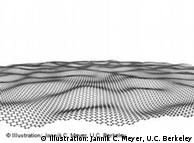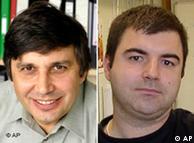Graphene is the thinnest solid ever known, indeed the thinnest possible: it is a sheet of linked carbon atoms just one atom thick. It is a great conductor of electricity and nearly transparent to visible light, but is impermeable to gases and liquids. It has so many surprising properties it has earned its discoverers a Nobel prize. The Economist explains the fuss about graphene http://econ.st/1JEX1pf
IBM Preps Graphene For High-Frequency Chips
Graphene is composed of a single layer of carbon atoms arranged in the form of a hexagonal lattice. It is the thinnest and lightest substance known, as well as being the strongest (more than 100 times stronger than high-strength steel). Now the first commercially viable consumer product based on the material has been produced: a lightbulbhttp://econ.st/1dwiKlU
石墨烯
石墨烯(Graphene)是一種由碳原子以sp2雜化軌道組成六角型呈蜂巢晶格的平面薄膜,只有一個碳原子厚度的二維材料[1]。石墨烯一直被認為是假設性的結構,無法單獨穩定存在[1],直至2004年,英國曼徹斯特大學物理學家安德烈·海姆和康斯坦丁·諾沃肖洛夫,成功地在實驗中從石墨中分離出石墨烯,而證實它可以單獨存在,兩人也因「在二維石墨烯材料的開創性實驗」為由,共同獲得2010年諾貝爾物理學獎[2]。
石墨烯目前是世上最薄卻也是最堅硬的奈米材料[3],它幾乎是完全透明的,只吸收2.3%的光"[4];導熱系數高達5300 W/m·K,高於碳奈米管和金剛石,常溫下其電子遷移率超過15000 cm2/V·s,又比奈米碳管或矽晶體(monocrystalline silicon)高,而電阻率只約10-6 Ω·cm,比銅或銀更低,為目前世上電阻率最小的材料[5][1]。因為它的電阻率極低,電子跑的速度極快,因此被期待可用來發展出更薄、導電速度更快的新一代電子元件或電晶體。由於石墨烯實質上是一種透明、良好的導體,也適合用來製造透明觸控螢幕、光板、甚至是太陽能電池。
石墨烯另一個特性,是能夠在常溫下觀察到量子霍爾效應。
IBM Preps Graphene For High-Frequency Chips
A material called graphene has been making lots of headlines in science journals, and is sometimes even discussed as a potential successor to silicon in computer chips. IBM doesn't buy that prediction, but is still betting big on the substance.
RESEARCH | 05.10.2010
Nobel Prize for physics goes to Russian duo for 'groundbreaking work'
The 2010 Nobel Prize for physics has been awarded to two European scientists, Andre Geim of the Netherlands and Russian-British national Konstantin Novoselov, for their pioneering work on graphene, an atom-thick form of carbon which is expected to play a large role in electronics.
The Royal Swedish Academy of Sciences awarded the prize to the pair for their "groundbreaking experiments regarding the two-dimensional material graphene," according to a statement released on Tuesday. Graphene is both the thinnest and strongest material known: almost completely transparent yet so dense that not even the smallest gas atom can pass through it.
Geim, 51, and Novoselov, 36, who are both Russian-born and based at Manchester University in the United Kingdom, were able to isolate graphene for the first time by extracting it from a piece of graphite like that found in ordinary pencils.
The Nobel committee said experiments with graphene could lead to the development of new material and the manufacture of innovative electronics, and that one possible application of the winners' work could be in researching new ways to trace dangerous gases.
"Since it is practically transparent and a good conductor, graphene is suitable for producing transparent touch screens, light panels and maybe even solar cells," the academy said in a statement.
Geim says 'no change' in schedule after award
Novoselov is one of the youngest Nobel Laureates for physics ever. In 1973, Brian David Josephson, a British scientist, shared the prize at the age of 33.
Geim told press he who had been answering emails when he was informed of the win. He said one of his first thoughts was: "Oh dear – I will not win many other prizes."
According to the Nobel Prize's official Twitter account, Geim did not expect to win the award this year, and added: "He plans to go back to work today, no changes in today's schedule!"
Previously, Geim was awarded an Ig Nobel award – an American humorous science prize – in 2000 for having conducted research into diamagnetic levitation, which resulted in levitating a frog.
The Nobel Prize includes 10 million Swedish kronor (just over 1 million euros, or $1.5 million), to be shared between the two winners.
The first Nobel Prize for physics was awarded to Wilhelm Roentgen for his discovery of X-rays in 1901. John Bardeen was the only Nobel Laureate who was awarded the Nobel Prize for physics twice, in 1956 and 1972.
Author: Sophie Tarr (AP/ Reuters)
Editor: Cyrus Farivar
Editor: Cyrus Farivar
Graphene - Wikipedia, the free encyclopedia
- [ 翻譯此頁 ]石墨烯- 維基百科,自由的百科全書
跳到 氧化石墨烯(graphene oxide): ). 通過對石墨烯進行氧化及化工處理,然後使他們漂浮在水中,石墨烯會剝落並形成有強力鍵的單層。這些被稱為氧化石墨烯的 ...




沒有留言:
張貼留言